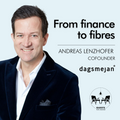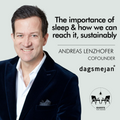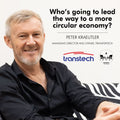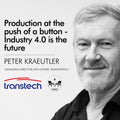How Unexpected Creatures May Be the Solution For Water Pollution In The Fashion Industry
You are an avid recycler.
You switched from single-use plastic straws and now carry your own monogrammed metal one.
You choose your online shopping sites based on their commitments to sustainability.
You flinch at the sight of beaches strewn with plastic.
You even bought a bamboo keep-cup for your morning caffeine fix.
But, the reality is that plastic continues to invade your life in every way possible...
Photo by Jordan Beltran
AN ASTRONOMICAL THREAT TO THE HEALTH OF HUMANS
It’s present while people eat - it’s in our food.
We fall asleep with it every night - it’s in most bed sheets, linen and mattresses.
We wear it - it’s coating the threads of some of our clothing.
Plastic is everywhere.
It’s practically invisible too.
Microfibres are essentially broken-down shreds of plastic less than 1mm in diameter. These miniature fibers are not only present in day-to-day life, they end up in the deepest parts of the ocean. Almost undetectable, they are an astronomical threat to the health of humans, the environment and marine life.
Every year the fashion industry releases half a million tons of such microfibers into the ocean. These are unfortunately fibers that will not decompose.
AN ASTRONOMICAL THREAT TO THE HEALTH OF HUMANS
It’s present while people eat - it’s in our food.
We fall asleep with it every night - it’s in most bed sheets, linen and mattresses.
We wear it - it’s coating the threads of some of our clothing.
Plastic is everywhere.
It’s practically invisible too.
Microfibres are essentially broken-down shreds of plastic less than 1mm in diameter. These miniature fibers are not only present in day-to-day life, they end up in the deepest parts of the ocean. Almost undetectable, they are an astronomical threat to the health of humans, the environment and marine life.
Every year the fashion industry releases half a million tons of such microfibers into the ocean. These are unfortunately fibers that will not decompose.
MICROPLASTICS LAND UP IN THE OCEAN
Synthetic plastic fibers - polyester, nylon, and acrylic - are inexpensive and versatile, which is why they are widely used. A negative aspect of fashion is that these fibers currently constitute almost 60% of the material used in the creation of clothing.
As noted by SustainYourStyle; these shedded microfibres “easily make their way to drinking water and marine life when washed in domestic washing machines”. This is because when such clothing items are washed, microplastics leach into sewage systems and, ultimately, land up in the ocean. More often than not, synthetic fabrics are simultaneously used with dangerous dyes, which also seep into water supplies upon washing either at home or the site of manufacturing. According to SustainYourStyle, “manufacturers tend to use various chemicals in order to produce cheap apparel which results in water and soil pollution, more toxic waste and other negative environmental impacts.”
700 000 of these microfibres are released in every wash cycle.
MICROPLASTICS LAND UP IN THE OCEAN
Synthetic plastic fibers - polyester, nylon, and acrylic - are inexpensive and versatile, which is why they are widely used. A negative aspect of fashion is that these fibers currently constitute almost 60% of the material used in the creation of clothing.
As noted by SustainYourStyle; these shedded microfibres “easily make their way to drinking water and marine life when washed in domestic washing machines”. This is because when such clothing items are washed, microplastics leach into sewage systems and, ultimately, land up in the ocean. More often than not, synthetic fabrics are simultaneously used with dangerous dyes, which also seep into water supplies upon washing either at home or the site of manufacturing. According to SustainYourStyle, “manufacturers tend to use various chemicals in order to produce cheap apparel which results in water and soil pollution, more toxic waste and other negative environmental impacts.”
700 000 of these microfibres are released in every wash cycle.
ENTER TECHNOLOGY & DIGITALIZATION
As consumers call for transparency and the demand for ecologically conscious products increases, new technologies are on the rise to transform the design and production of clothing. This, accompanied by the immense threat to marine and human life, highlights the urgent need for sustainable technologies in the fashion industry.
Developments in the digitalization of fashion, and particularly within 3D printing, have the potential to eliminate waste during the manufacturing processes. This type of technology could enhance automation within the manufacturing process while protecting the world and its oceans, allowing for garments to be produced on a need by need basis. This avoids excess stock and prevents unused fabric and offcuts from ending up in landfills. The current issue with 3D printing, however, is the tendency to use synthetic polymers.
Technology and sustainability need to work hand-in-hand
While reduced waste is impactful in and of itself, there is still the real possibility for an even greater impact to be had, especially when paired with sustainable materials instead.
Alternative textiles are developing beyond plant-based fabrics, with bio-fabricated textile technologies potentially becoming a significant player in the protection of the world’s oceans.
Technology and sustainability need to work hand-in-hand.
Some companies are using fermented yeast cells and mushroom structures to create leather-like textiles. While other biotechnology companies are being inspired by biomimicry - the science of imitating nature.
A silk-like textile has even managed to be created out of the same proteins used to spin a spider’s web. Harnessing the innovation of nature is not something that is new to humanity and its love affair with fashion. Especially when considering the modest silkworm, who has the primary role of producing the fiber that is spun into 34 000 tonnes of raw silk each year.
HUMBLE BEE
Drawing inspiration from a solitary bee, Humble Bee is set to create waves in the textile industry.
In nature, this bee makes a polyamide-protein to line its nest. The nesting material is both water- and chemical-resistant, and retains its structure even when exposed to high temperatures.
Humble Bee is focused on exploring this protein’s revolutionary properties, which make it similar to plastic, to create a sustainable and natural solution. The New Zealand based start-up aims to combat plastic pollution by replacing existing synthetic plastics with their novel bioplastic counterpart.
Bizarre Mooder
Drawing inspiration from a solitary bee, Humble Bee is a solution-driven company making waves in the fashion industry. In nature, this bee makes a polyamide-protein to line its nest.
Bizarre Mooder
The nesting material is both water- and chemical-resistant and retains its structure even when exposed to high temperatures. Humble Bee is focused on exploring this protein’s revolutionary properties, which make it similar to plastic, to create a sustainable and natural solution. The New Zealand based start-up aims to combat plastic pollution by replacing existing synthetic plastics with their novel bioplastic counterpart.
People are aware of the dangers of plastic pollution, but there is only so much that changes in habit can achieve. When an industry itself is at fault for using plastic in their manufacturing processes, the genesis of the problem is perpetuated there.
Now is the time for the fashion industry to take steps towards sustainable practices and technologies in each and every aspect of their supply chain. These will be most fruitful for the world at large, and for our oceans.







